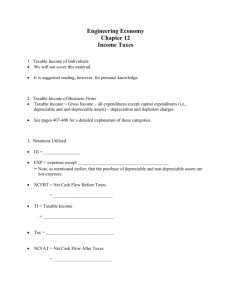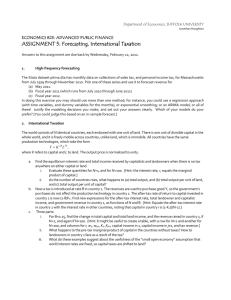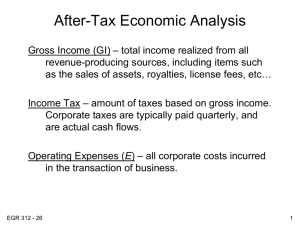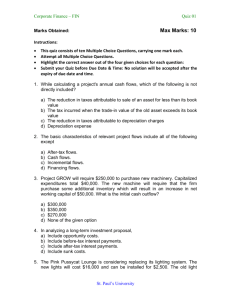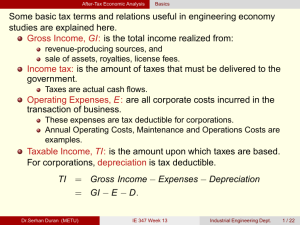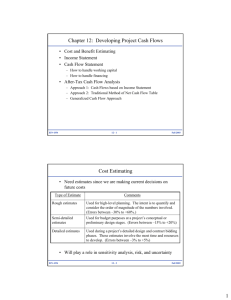Chapter 17 – After-Tax Economic Analysis
advertisement
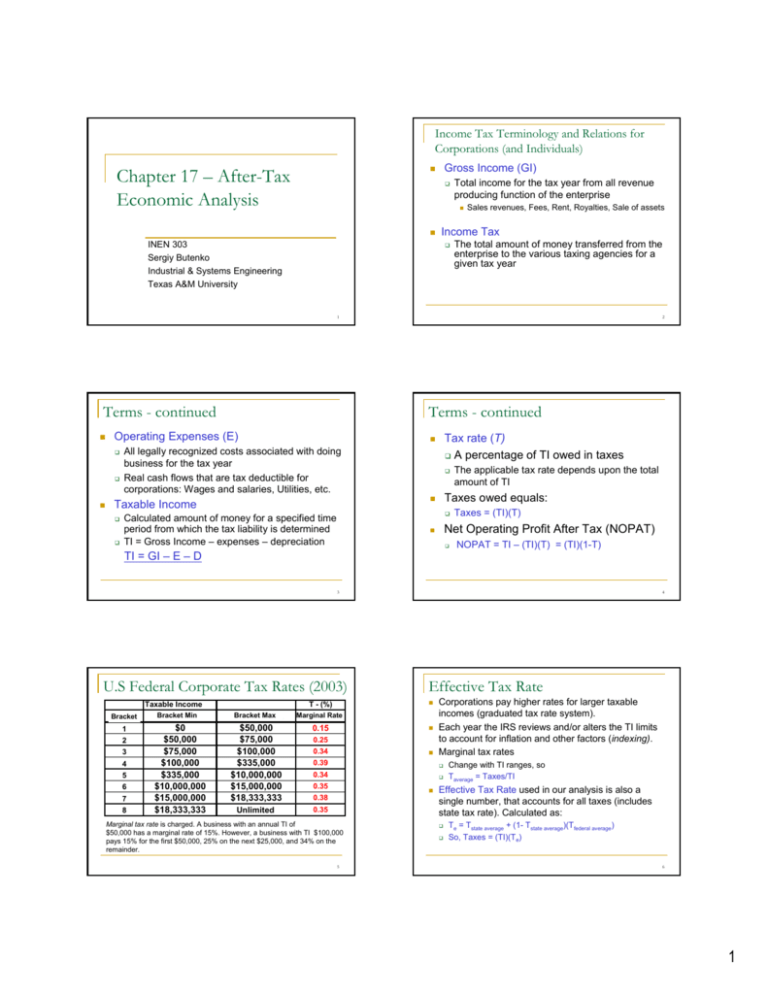
Income Tax Terminology and Relations for Corporations (and Individuals) Gross Income (GI) Chapter 17 – After-Tax Economic Analysis Total income for the tax year from all revenue producing function of the enterprise Sales revenues, Fees, Rent, Royalties, Sale of assets Income Tax INEN 303 Sergiy Butenko Industrial & Systems Engineering Texas A&M University The total amount of money transferred from the enterprise to the various taxing agencies for a given tax year 1 Terms - continued Terms - continued Operating Expenses (E) Tax rate (T) A percentage of TI owed in taxes All legally recognized costs associated with doing business for the tax year Real cash flows that are tax deductible for corporations: Wages and salaries, Utilities, etc. Calculated amount of money for a specified time period from which the tax liability is determined TI = Gross Income – expenses – depreciation The applicable tax rate depends upon the total amount of TI Taxes owed equals: Taxable Income 2 Taxes = (TI)(T) Net Operating Profit After Tax (NOPAT) TI = GI – E – D NOPAT = TI – (TI)(T) = (TI)(1-T) 3 U.S Federal Corporate Tax Rates (2003) Taxable Income Braket Bracket 1 2 3 4 5 6 7 8 Bracket Min Braket Min $0 $50,000 $75,000 $100,000 $335,000 $10,000,000 $15,000,000 $18,333,333 4 Effective Tax Rate T - (%) Bracket Max Rate Brkt. Rate Bracket Max Marginal 0.15 $50,000 0.25 $75,000 0.34 $100,000 0.39 $335,000 0.34 $10,000,000 0.35 $15,000,000 0.38 $18,333,333 0.35 Unlimited Sky's the limit! Marginal tax rate is charged. A business with an annual TI of $50,000 has a marginal rate of 15%. However, a business with TI $100,000 pays 15% for the first $50,000, 25% on the next $25,000, and 34% on the remainder. 5 Corporations pay higher rates for larger taxable incomes (graduated tax rate system). Each year the IRS reviews and/or alters the TI limits to account for inflation and other factors (indexing). Marginal tax rates Change with TI ranges, so Taverage = Taxes/TI Effective Tax Rate used in our analysis is also a single number, that accounts for all taxes (includes state tax rate). Calculated as: Te = Tstate average + (1- Tstate average)(Tfederal average) So, Taxes = (TI)(Te) 6 1 Basic Tax Equations - Individual Gross Income GI = salaries + wages + interest and dividends + other income (a) Taxable Income TI = GI – personal exemptions – standard or itemized deductions (b) Tax T = (taxable income)(applicable tax rate) 7 U.S. Individual Federal Tax Rates (2003) Tax Rate (1) 8 Before-Tax and After-Tax Cash Flow Taxable Income, $ Filing Single Filing Married and Jointly (3) (2) NCF = cash inflows – cash outflows Cash Flow Before Tax (CFBT) 0.10 0-7,000 0-14,000 0.15 7,001-28,400 14,001-56,800 0.25 28,401-68,800 56,801-114,650 0.28 68,801-143,500 114,651-174,700 0.33 143,501 – 311,950 174,701-311,950 0.35 Over 311,950 Over 311,950 CFBT = gross income – expenses – initial investment + salvage value = GI – E – P + S Cash Flow After Tax (CFAT) CFAT = CFBT – Taxes = CFBT – (TI)(Te) CFAT = (GI – E – P + S) – (GI – E – D)(Te) Note that depreciation is not a real cash flow, but it has a “positive” effect! 9 Before-Tax and After-Tax Cash Flow 10 Example 17.3 11 A company expects to initiate a new outreach service next year. Small facilities will be constructed in about 35 cities across the continent. Each facility is expected to cost $550,000 initially with a resale (salvage) value of $150,000 after 6 years—the time period for which the company’s Board of Directors approved this activity. MACRS depreciation allows a 5-year recovery period. The company estimates bottom-line results at annual net increases to the corporation of $200,000 in revenue and $90,000 in costs. Using an effective tax rate of 35%, tabulate the CFBT and CFAT estimates. 12 2 Effect of Different Depreciation Methods Criteria used to compare different depreciation methods n PWtax = ∑ (taxes in year t)(P/F,i,t) t=1 Given recovery period n, choose the depreciation rates that minimize the PW of taxes paid in future This is equivalent to maximizing the present worth of depreciation n PWD = ∑ Dt ( P / F , i, t ) t =1 13 Comparing Depreciation Methods Capital Gains (Losses) for Corporations Assumptions 14 Effective Tax rate is a constant CFBT exceeds annual depreciation under all methods All depreciation methods reduce BV to S in n years Capital Loss (CL) if SP < P Consequences Selling price is SP and first cost is P For Non-depreciating assets Capital gain (CG) if SP > P The total taxes paid are equal for all depreciation models The PW of taxes paid is less for accelerated depreciation methods CG = SP – P CL = P – SP Note: For a fixed depreciation method and varying n, PWtaxes is less for smaller n values See Examples 17.4 and 17.5 15 16 Depreciation Recapture and Capital Losses for Corporations Selling price is SP, Book value is BVt and initial investment is P For Depreciating assets Depreciation Recapture (DR) if BVt < SP < P DR and Capital Gain (CG) if SP > P Capital Loss (CL) if SP < BVt DR = SP – BVt DR = P-BVt and CG = SP - P CL = BVt - SP 17 18 3 General TI Equation – for Corporations After-Tax PW, AW, and ROR Evaluation The basic TI equation is: TI = GI – E – D + CG + DR– CL + – Gross income, Capital gain, Depreciation Recapture Work with CFAT instead of NCF and aftertax MARR instead of before-tax MARR One project Expenses, Depreciation, Capital Loss Apply PW or AW >= 0 for selection Accept the project if after-tax MARR <= i* i* is the after-tax break-even ROR Two or More Projects Select the alternative with the largest PW or AW value Incremental after-tax break-even ROR analysis 19 An Approximate Relationship 20 After-Tax Replacement Study Before-tax MARR = After-tax MARR/(1-Te) Before-tax ROR = After-tax ROR/(1-Te) Only for non-depreciating assets. Similar to before-tax analysis but carried out with CFAT After-tax treatment of a replacement problem will generate a different data set than a before-tax replacement analysis Could have DR, CG, CL situations See Example 17.12 and Table 17-6 After-tax replacement analysis is more involved An after-tax analysis could reverse a before-tax analysis on some problems See Example 17.8 21 22 After-Tax Value Added Analysis Value added is a term to indicate that a product or a service has added value to the consumer or buyer To start, apply the equation for Net Operating Profit After Tax: NOPAT = Taxable Income – taxes = (TI)(1-Te) Economic Value Added ( EVA) is the amount of NOPAT remaining after removing the cost of invested capital during the year EVA = NPAT – cost of invested capital = (TI)(1-Te)– (after-tax MARR)(BVt-1) 23 4

